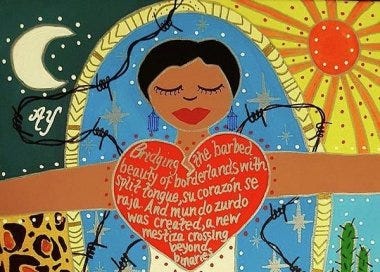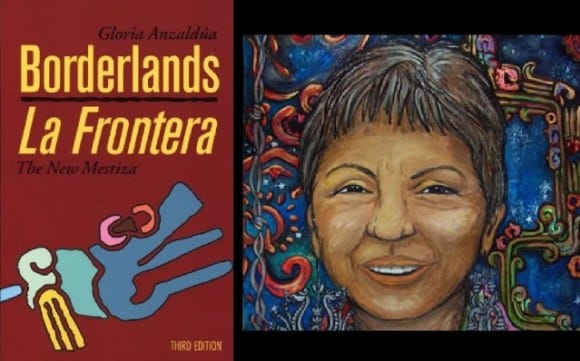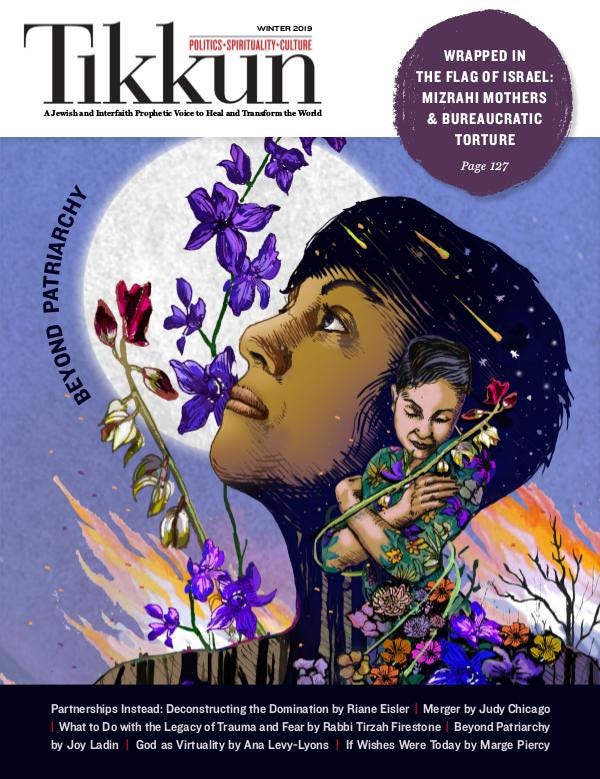For my whole life I’ve considered myself a “bridger”: someone who sees the truths and strengths in multiple perspectives, and tries to integrate them. Perhaps this is a function of my role as a middle child; wherever its genesis, I’ve always felt it deeply. This is why I opted not to go to law school with its adversarial domination system (winners and losers) and instead to study conflict management and mediation, with its focus on finding common ground and positive sum solutions. It’s also why I refused to choose a major in college, ultimately creating my own interdisciplinary major.
Being a bridge-builder is a simultaneously energizing and isolating role. The energy comes through synergy and synthesis: creating new possibilities through integration and recombination. The isolation comes from never really belonging: the curse of living in liminal space is never really having a home. As bell hooks says, “the problem with being a bridge is you get walked on.”
So today I want to explore different ways of thinking about what it means to build bridges, and present some of the voices I’m in dialogue with around why bridging feels so important in this moment.
TL;DR: I believe the concept of “bridging” is the key to how we collectively build the world of belonging we all so desperately want. It’s a way of transcending binaries, opening up new possibilities, and connecting not just across differences but precisely because of them.
Bridging as a way of being: the work of Gloria Anzaldúa
What prompted this post was encountering for the first time the work of Chicana queer feminist, activist, and theorist Gloria Anzaldúa. My introduction to bridging as a concept came through john powell (more on that below), where he talks of bridging as a tactic: a thing you do to connect across difference.
But Anzaldúa got there first, centering the bridging metaphor in her own identity and lived experience: it’s not only what she does, it’s who she is. Her foundational 1987 book La Frontera/Borderlands introduces the concept of “mestiza consciousness”, a framework for acknowledging her many identities.
Here’s a taste, gorgeous prose coupled with deep insight:
I am a wind-swayed bridge, a crossroads inhabited by whirlwinds. Gloria, the facilitator, Gloria the mediator, straddling the walls between abysses. ‘Your allegiance is to La Raza, the Chicano movement,’ say the members of my race. ‘Your allegiance is to the Third World,’ say my Black and Asian friends. ‘Your allegiance is to your gender, to women,’ say the feminists. Then there’s my allegiance to the Gay movement, to the socialist revolution, to the New Age, to magic and the occult. And there’s my affinity to literature, to the world of the artist. What am I? A third world lesbian feminist with Marxist and mystic leanings... Who, me confused? Ambivalent? Not so. Only your labels split me. (from La Prieta, emphasis in original)
I’m reminded of Whitman’s refrain: “I am large. I contain multitudes.” (Don’t we all?)
Toward post-oppositional politics
I’m now in the middle of a crash-course on Anzaldúan theory (she passed away in 2004) and it’s incredible on so many levels. In my view, exactly what the world needs in this moment. I’m grateful to have expert guidance from AnaLouise Keating, a longtime collaborator with Anzaldúa and her literary executor. Keating has been generous to share her scholarship and brainpower (this essay is a great introduction to Anzaldúa’s work), and is curating a body of work under the admittedly imperfect heading of “post-oppositionality.” Here’s Anzaldúa in La Frontera, explaining why this approach is necessary:
It is not enough to stand on the opposite river bank, shouting questions, challenging patriarchal, white conventions. A counter stance locks one into a duel of oppressor and oppressed; locked in mortal combat…both are reduced to a common denominator of violence. The counter stance refutes the dominant culture’s views and beliefs, and for this it is proudly defiant. All reaction is limited by, and dependent on, what it is reacting against… At some point, on our way to a new consciousness, we will have to leave the opposite bank, the split between the two mortal combatants somehow healed so that we are on both shores at once and, at once, see through serpent and eagle eyes.
At once so lyrical and so powerful: a call to transcend binaries. Anzaldúa subsequently elaborated on this intuition with her concept of “Conocimiento” which like all of her work, represents what Keating calls “a nonbinary, connectionist mode of thinking.”
Keating expands on this body of work in a recent essay in Tikkun calling for post-oppositional transformation—from, appropriately, the Beyond Patriarchy issue—accessible here. It’s brilliant.
On “de-centering the binary”
At the same time that I was diving into Anzaldúa’s work, I was also continuing my deep-dive into queer theory and looking specifically for a trans critique of patriarchy (isn’t that how everyone spends their Saturday nights?) I stumbled across this phenomenal essay from Julia Serano, who I find to be consistently among the clearest and most incisive trans theorists out there. In it she distinguishes between “reverse discourse” versus “decentering the binary” approaches to trans scholarship, movement building, and language. The whole essay is worth the read, but here’s how she describes it in the context of the cis/trans debate:
While the first approach that I described merely decenters the dominant group (thus creating two legitimate groups: cis and trans people), reverse discourses re-center the binary on the marginalized group. Rather than reducing the social significance of the cis/trans binary, a reverse discourse emphasizes it—after all, one only gains the authority to speak about trans people and related matters of gender if one can indisputably claim a trans identity.
It felt like a light-bulb going off. Yes! Serano gave voice to something I’ve long felt but didn’t really have language for. A deep discomfort with reverse-discourse approaches (which, following Anzaldúa’s work, remain locked in an oppositional dominant culture paradigm), and an attraction to those critiques that sought instead to embrace multiple truths. There are obvious parallels to feminism (men as monolithic oppressors) and race (white people as monolithic oppressors) and many other contexts as well. I confess it’s also deeply gratifying—as a white man—to find these same sentiments expressed by people who are not white men. For of course I always fear that my nagging discomfort is just a reflection of my own identities… and my desire not to be exclusively defined by them.
I’m reminded here of watching Scot Nakagawa speak last year at Facing Race where he talked about how in discussing race we can inadvertently “reify” the very categories we are trying to dismantle (this article expands on that point).
On bridging vs breaking
Serano’s distinction immediately brought up for me john powell’s thinking about “bridging” vs “breaking” in the context of politics, movements, and language. Here “breaking” is almost perfectly synonymous with a reverse discourse approach; bridging is about decentering the binary and holding multiple truths. powell explains:
Bridging… is about connecting to the other. The other is always imaginary. There’s no natural other. There’s no natural community. We are constituting these constantly. But bridging actually invites a sense of empathy, deep listening, and connection.
Breaking sees the other as a threat, sees the other with fear, as somehow attacking who we are. And most of the stories, most of the practices that we engage in in our society, even in progressive communities, are breaking. We’re constantly defining ourselves in opposition to the other. We’re constantly defining the “we” in a narrow way.
And so again, that’s the big fight, not just in the United States, but throughout the world. Do we bridge or do we break?
As john is fond of saying: it’s not identity politics that’s the problem, it’s “breaking” politics. Or as Serano might say, it’s “reverse discourse” that’s the problem. What’s nice about Serano’s essay is how much empathy she holds for the decision to “break”: she recognizes the value and appeal of a reverse discourse approach, even as she rejects its utility as a strategy for collective liberation. So too with Keating: I love how careful she is in her language around “post-oppositionality”:
Post-oppositionality does not entirely reject oppositional consciousness but instead moves through it, taking what’s useful and transforming (rather than negating or denying) the rest. Post-oppositionality stays in relationship with oppositionality.
On synthesis (bridging?) as the wellspring of innovation
This approach to “taking what’s useful and transforming the rest” also really resonated with me. It reminded me of Ken Wilber’s notion of “include and transcend” — building on what came before and yet not being limited by it:
Transcend and include... this is the self-transcending drive of the Kosmos—to go beyond what went before and yet include what went before... to open into the very heart of Spirit-in-action. -A Brief History of Everything
I’ve never considered myself a “creative” person: I’m way too in my own head all the time (stuck in my left brain, victim to yet another false binary). Even to this day I carry some version of imposter syndrome around my intellectual contributions to this world, because they always feel derivative: so little is my own “original” thinking, so much is synthesis, recombination… standing on the shoulders of giants.
So I was delighted a few years back to find this beautiful essay on “How to think like Shakespeare,” where Scott Newstok contends:
You simply cannot transform tradition (a creative ideal) without first knowing it (a conserving ideal). Making an inventory must precede making an invention.
He lauds the Bard’s “radical sense of empathy”, what Zadie Smith called his ability “to always see both sides of a thing”… in short, the ability to “see truth plurally.” It clicked for me: this is the art of bridging, and its unique value. It is the art of synthesis, the basis for creation and for opening up new potential, to help us move forward… to get unstuck. What is a new idea but a new way of thinking about an old idea?
On bridging as empathy
I love this short animated distillation of Brene Brown’s scholarship on empathy:
She describes the four pillars of empathy, as identified by Theresa Wiseman:
Perspective-taking (ability to take the perspective of another person)
Staying out of judgement
Recognizing emotion in other people (understanding what they’re feeling)
Communicating that you understand their feelings (naming and echoing)
Small wonder that we see so many people acting without empathy: it requires the ability to bridge. To put yourself in another’s shoes. To understand YOUR OWN feelings enough to recognize them in others. Here’s Brown:
Empathy is a choice, and it's a vulnerable choice because in order to connect with you, I have to connect with something in myself that knows that feeling.
Anyone else seeing some patriarchy links here?
On the pain and difficulty of bridging
At the same time that I’m sitting with Anzaldúa, Keating, and Serano, I was reading Ursula Le Guin’s science fiction classic The Dispossessed, at the recommendation of adrienne maree brown. It’s a beautiful and provocative read, and I found myself identifying with Shevek, the protagonist. Shevek moves literally between worlds, trying to bridge in his own body and mind the chasms separating his home planet from its near neighbor. He offers this insight:
To him a thinking man's job was not to deny one reality at the expense of the other, but to include and connect. It was not an easy job.
Yes! That’s it: to see plural truths, to reject—and transcend—the binary. It is a lonely and isolating role. I’m reminded of a conversation I had last year with Mallika Dutt, where we each resonated around the notion of how lonely it is to live in liminal space, to be forever between worlds without the comfort of calling one home.
Here’s Keating again:
Post-oppositional work is not easy. The willingness to witness all sides can lead to accusations of disloyalty, stupidity, and (ironically) bias.
My wife Jennifer offered an interesting way of thinking about this. Where I find myself drawn to the MLKs, to the Mandelas, to the Aung San Suu Kyis… she reminded me that we also need the LBJs, the de Klerks, the Thein Seins. It is hard to be the bridge, the oppressed reaching out to the oppressor. But it takes both sides, and the blowback can be fierce. Yes Dr. King was assassinated by an angry white man; but Yitzhak Rabin was assassinated by a fellow Israeli Jew. I found myself reflecting on this recently re-watching the powerful scene from Game of Thrones where Jon Snow voyages to Hardhome with Tormund: each of them displaying incredible courage to bridge their two deeply divided constituencies.
Bridging as solidarity
I read two pieces recently that prompted this thought: solidarity is how we implement belonging. Belonging is what we all want and need, but it’s an inherently relational yearning. It requires others—someone or something to belong to and with. Bridging is how we connect with others. Bridging then is an action: another way of describing—or showing—solidarity.
Astra Taylor and Leah Hunt-Hendrix offered this beautiful and impassioned call for resurrecting the ideal of solidarity. I love this:
A solidarity aiming at transformational change—the horizon toward which solidarity must now, of necessity, be directed—demands we not just recognize and sympathize with the plight of others but also join them as equals, reaching across differences without erasing them. Solidarity in its sublime form shatters the boundaries of identity, connecting us to others even when we are not the same.
At the same time I came across a concept note describing “collaborative solidarity”, from Allen Kwabena Frimpong and others (not yet ready for public sharing; Curtis Ogden shares an overview of the concept here). The thing that resonated for me: we need both new ways of being, and new ways of doing. And it’s always about relationship, about connection. And there is something about belonging, bridging, solidarity, that blends these concepts beautifully and seems to illuminate the path forward… at least to me. Here’s Taylor and Hunt-Hendrix again:
Solidarity both produces community and is rooted in it, and is thus simultaneously a means and an end. Solidarity is the practice of helping people realize that they—that is to say, we—are all in this together.
The radical potential of bridging
This to me is the most exciting realization of the global moment we’re in: this appreciation for our deep interdependence, the capacity and promise of a world where everyone truly belongs. Here’s adrienne maree brown, writing in 2010 on the unique vantage point of people who’s very identities transcend false binaries (echoing Anzaldúa):
Whether we want to admit it, more of us are mixed race or cross-cultural than not. When we recognize our multicultural lineage, we become part of a transformation that’s emerging from every corner of society—from philosophy to complex sciences to environmentalism. Post-partisan, post-binary, we are starting to embody our whole selves. We are proof that contradictions can coexist, proliferate, and create rich, new possibilities. As we tear down the walls of colonization, a previously unimaginable future can become reality.
adrienne was ahead of her time, but the world is finally catching up. And this is the beauty of her first sentence: we are ALL bridgers in some way - there is no such thing as a single identity. We contain multitudes. We all have something to gain from valuing all the different parts of our identities.
So that’s it. I wanted to put these thoughts together because they’ve been demanding more attention than I’ve been able to give them just yet, and they feel like such an urgent response to this moment. As Miki Kashtan posed the question recently: “What would it look like to build a movement for the 100%?”
It also underscores the core premise of an initiative I’ve been collaborating on over the last year: the urgent need for bridgers. They—we—have a unique role to play in this moment. It may be isolating, it may be painful, but it’s necessary. And as Anzaldúa reminds us:
No hay puentes, se hace puentes al andar (There are no bridges, we make the bridges by walking)
Bridge-builders of the world, unite!





I just came across this article last weekend, three years after you first cast it out into the world, and haven’t been able to stop thinking about it—this is one of the most impactful articles that I have read in a very long time (I only wish it was an entire book!). When I saw that it didn’t have more likes/traction, I thought “What, how?!?”—this deserves to reach thousands of people. On feeling like an imposter because of a tendency to write in synthesis and recombination (bridging, like you said!): If you still ever feel that now, I just have to share that you were able to dynamically balance so many considerations at once in a way that I have seen attempted many times (including myself haha) and very rarely achieved at this degree of intentionality, integration, and novel connection. I think that the role of a writer as a weaver is vital, especially in an age of overflowing information and community disconnection. I just shared a compilation list called Resonant Resources via my Substack and featured your article so that it can ripple farther and wider! Thank you for your creativity. -Maggy